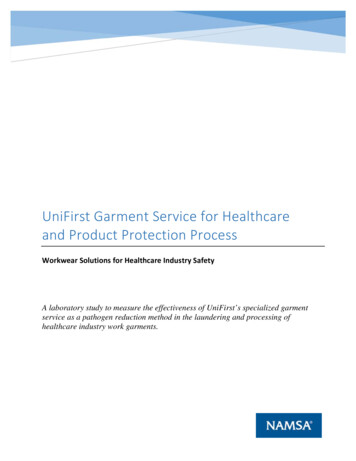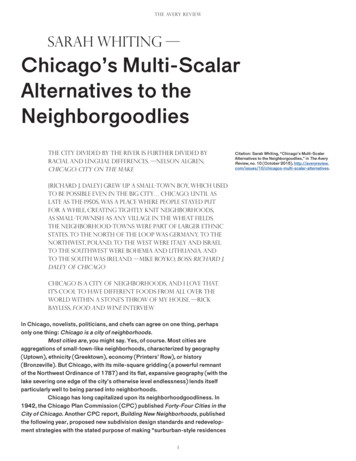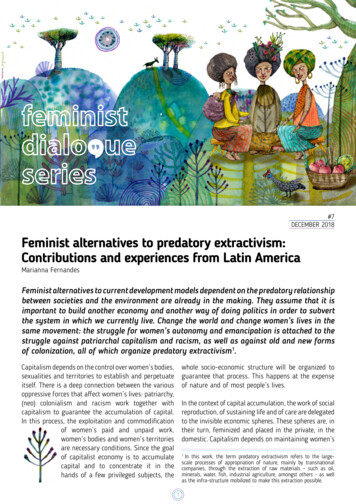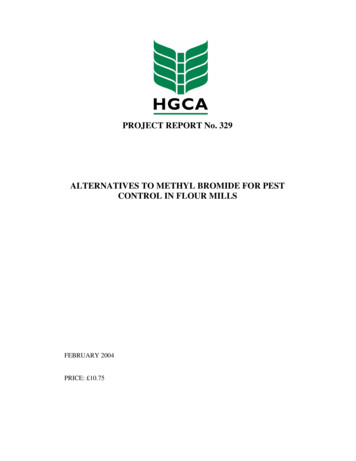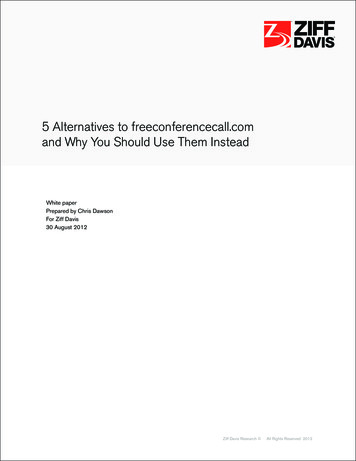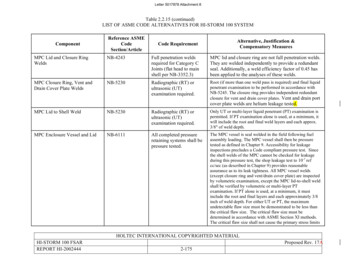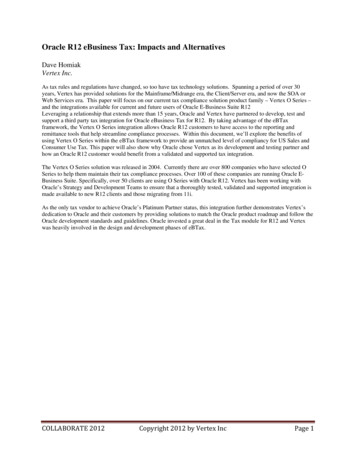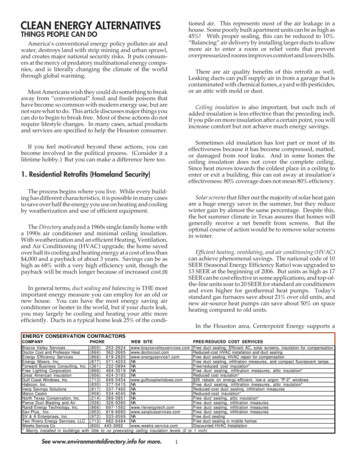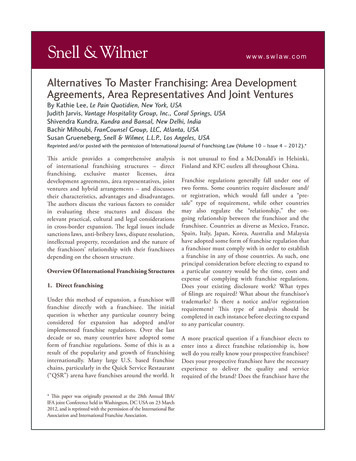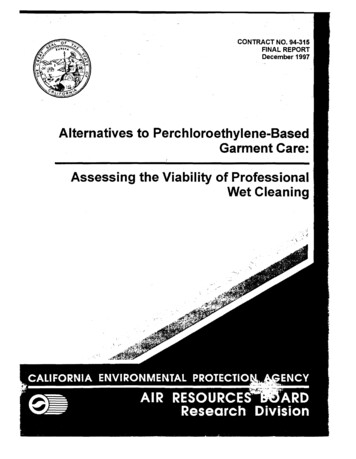
Transcription
CONTRACT NO. 94-315FINAL REPORTDecember 1997Alternatives to Perchloroethylene-BasedGarment Care:Assessing the Viability of ProfessionalWet Cleaning
Alternatives to Perchloroethylene-Based Garment Care:Assessing the Viability of Professional Wet CleaningFinal ReportContract No. 94-315Prepared for:California Air Resources BoardResearch Division2020 L StreetSacramento, CA 95814Prepared by:Robert Gottlieb,Principal InvestigatorPeter Sinsheimer,Senior Research AssociateJessica Goodheart,Project ManagerCraig Tranby,Research AssociateLaura Bechtel,Research AssociateUniversity of California, Los AngelesPollution Prevention Education and Research CenterBoelter Hall, Room 7440Los Angeles, CA 90024December, 1997
For more information about the ARB's Research Division,its research and activities, please visit our Web site:http://www.arb.ca.gov/rd/rd.htm
DedicationThis Report is dedicated to the late Julie Roque. Through her passionate pursuit of theideals and goals of pollution prevention, which she understood were embedded in thecomplexities of analysis and the details of evaluation, she was always available to workwith and assist those seeking to identify pollution prevention solutions. We continue tomiss her.
DisclaimerThe statements and conclusions in this report are those of the Pollution PreventionEducation and Research Center and not necessarily those of any institution that has fundedthis work. The mention of commercial products, their source, or their use in connectionwith material reported herein is not to be construed as actual or implied endorsements ofsuch products.
AcknowledgmentsThis report required a wide range of input and technical review. A number of people providedsignificant support in terms of information, technical review, and comments. We would especiallylike to thank, among others: David Adelman (Wyatt-Bennett Equipment Corp.), Lisa Anderson(Metropolitan Water District), Angela Barranca (U.S. Environmental Protection Agency -- RegionIX), Chandrashekhar Bhatt (South Coast Air Quality Management District), Jim Bienias (RelianceWater Heater Co.), Kurt Chester (Rayne Company), Jenni Cho (Korean Youth and CommunityCenter), Jeananne Coop (California State University, Long Beach, Apparel Design andMerchandizing), Yoram Cohen (UCLA), Joe Chu (CaIOSHA), Deborah Davis (Owner, Cleaner byNature), Ron Deli (Multirnatic), Claudia Der-Martirosian (Lewis Policy Center, UCLA), DavidDeRosa (Greenpeace), Chris Dolan (Iowa Techniques), Sylvia Ewing-Hoover (Center forNeighborhood Technology), William Eyring (Center for Neighborhood Technology), Ken Faig(International Fabricare Institute), Barry Fine (London Cleaners), Jodean Giese (L.A. Dept. ofWater and Power), Ranji George (South Coast Air Quality Management District), BarryGershenson (Sterling Cleaners, former president of California Fabricare lnstitiute), Andrea Gough(California Energy Commission), Steve Green (Carriage Trade Cleaners), Deborah Hanlan (U.S.Environmental Protection Agency), Chris Hayes (Center for Neighborhood Technology), AndresHernandez (Plant Manager, Cleaner by Nature), Elizabeth Hill (Pollution Prevention Education andResearch Center), Sharon Howell (California Energy Commission), Christina Huber (PollutionPrevention Education and Research Center), Stewart Ilkowitz (Hi-Stearn Corporation), Sharon Im(Korean Youth and Community Center), Hazel Jackson (Associate Professor, California StateUniversity, Long Beach, Apparel Design and Merchandizing), Margaret Johnson (Lewis PolicyCenter, UCLA), Von Kennedy (RJ Cool), Kirn Kenson (California State University, Long Beach,Apparel Design and Merchandizing), Virginie Leenknecht (UCLA), Greg Leirarn (PROS), CharlesLemke (L.A. Dept. of Water and Power), Deborah Lerner (Pediatric & Family Medical Center),Hong Mai (L.A. Bureau of Sanitation), Bob McEntyre (Flourmatic), Traci Minarnide (L.A. Bureauof Sanitation), Mike Mowry (UCLA), Ung Sin (Mike) Na (past president, Korean Dry Cleaners &Laundry Association), Kari Nelson (California State University, Long Beach, Apparel Design andMerchandizing), Bruce Nordman (Lawrence Berkeley Laboratories), Gregory Ondich (UnitedStates Environmental Protection Agency), Dennis Page (Woods Electric), Gary Parker (RSDCooling Towers), Bhupendra Patel (L.A. Bureau of Sanitation), Jo Patton (Center forNeighborhood Technology), Howard A. Perlman (US Geographic Survey), Colleen Poteet(California State University, Long Beach, Apparel Design and Merchandizing), Winston Potts (AirResources Board), Ralph Propper (California Air Resources Board ), Peter Saarna (StatisticalConsultant, UCLA), Andy Sandcavage (Metropolitan Water District), Deborah Savage (TellusInstitute), Sam Schwartz (International Fabricare Institute), Rajesh Sharma (Pediatric & FamilyMedical Center), Donald Shoup (UCLA), Jodi Siegel (Toxics Use Reduction Institute), SueStanley (Area Coordinator, California State University, Long Beach, Apparel Design andMerchandizing), Anthony Star (Center for Neighborhood Technology), Pierre Sycip (South CoastAir Quality Management District), Sojeila Sylva (SEED Loan Fund), Wes Tanaka (SouthernCalifornia Edison), Warren Teitz (Metropolitan Water District), Steve Trainer (Iowa Techniques),Jim Tranquada (UCLA), Willie Valdez (L.A. Bureau of Sanitation), Elaine Vaughan (University ofCalifornia, Irvine), Julie Venturini (Energy Resource Center), Belinda Vigil (Lewis Policy Center,UCLA), Torn Votta (Tellus Institute), Patrice Wong (Korean Youth and Community Center), ToddWong (California Air Resources Board).Support for this report was made available through: the United States Environmental ProtectionAgency, Office of Research and Development; the South Coast Air Quality Management District;the California Air Resources Board; the Center for Environmental Risk Reduction, UCLA; theUniversity of California Toxic Substances Research and Training Program; and the Los AngelesCounty District Attorney's Office, Occupational and Environmental Division.
Table of ContentsPageNumberAbstract. .iExecutive Summary .iiPart I: Background and MethodsSection 1: Background to the Study.1.1 Pollution Prevention and the Gannent Care Industry.1-11-11-21-31.1.3 Professional Wet Cleaning as a Pollution Prevention Alternative. 1-51.1.4 Description of the Dry Cleaning and Wet Cleaning Processes.1-61.1.5 The Development of the Wet Clean Industry. 1-71.1.6 The Demonstration Site Evaluation1-81.2 Cleaner by Nature: A Pollution Prevention Demonstration Site. 1-111.2.1 Description of the Evaluation Period: the First Twelve Months of Operation. 1-121.2.2 Demonstration and Outreach. 1-151.2.3 Conclusion: Assessing Viability. 1-16l. 1. 1 The Pollution Prevention Approach.1.1.2 PCE-Based Dry Cleaning and the Need for a Pollution Prevention Approach.Section 2: Methods for Assessing Viability.2.1 General Research Method.2.2 Evaluation Criteria for Assessing the Viability of Wet Cleaning.2.3 The Study Design for Each Section of the Report.2-12-12-22-3Part II: ResultsSection 3: Performance Assessment of Wet Cleaning.3-13.1 Overview.3-13-33.2 Profile of Customer Gannents. . . . .3.2. l Volume.3-33.2.2 Garment Type. 3-43.2.3 Fiber Type. 3-53.2.4 Care Labeling. 3-63.2.5 Garment Profile Summary. 3-73.3 Analysis of Problem Gannents. . . . . . . . . . . . . . . . . . . . . . . . 3-83.3.1 Rejects. 3-83.3.2 Claims and Store Credit. 3-93.3.3 Garments Returned for Additional Work. 3-103.3.4 Summary ofProblem Garments. 3-14
PageNumber3.4 Repeat Clean Test . 3-163.4.13.4.23.4.33.4.43.4.5Dimensional Change Evaluation.General Appearance Evaluation.Color Change Evaluation.Odor Evaluation.Summary of Repeat Clean Test.3.5 Wearer Survey.3-173-233-253-273-283-293.5.1 Performance Quality: Wet Cleaning and Dry Cleaning. 3-293.5.2 Overall Satisfaction: Wet Cleaning and Dry Cleaning. 3-313-323.5.3 Wearer Survey Summary.3.6 Customer Satisfaction with Wet Cleaning.3.6.13.6.23.6.33.6.4Cleaner by Nature Customer Satisfaction Survey.Cleaner by Nature Customer Satisfaction Survey Summary . ;.Dry Cleaning Customer Survey.Dry Cleaning Customer Survey Summary.3-333-333-403-413-463.7 Summary Analysis of Performance Assessment. 3-48Section 4: Financial Assessment of Wet Cleaning.4.1 Overview.4.2 Cleaner by Nature Case Study.4-14-14-34.2.1 Start-Up Costs.4.2.2 Cleaner by Nature's Profit and Loss.4.2.3 Cleaner by Nature's Pressing Productivity.4.3 Cost Comparison of Cleaner by Nature and Dry Cleaning.4.3.1 Equipment Cost Comparison .4.3.2 Pressing Time Comparison .4.3.3 Cost Analysis: Cleaner by Nature and Dry Cleaning.4-34-64-124-134.4 Summary Analysis ofFinancial Assessment.4-28Section 5: Environmental Assessment of Wet Cleaning.5.1 Overview.5.2 Methods for the Environmental Assessment.5.3 Water Inputs and Outputs.4-144-184-215-15-15-25-55.3.1 Water Use.5-55.3.2 Water Discharge. 5-105.4 Energy Inputs and Outputs.5-155.4.1 Energy Use . 5-155.4.2 Energy Outputs. 5-205.5 Chemical Inputs and Outputs.5-225.5.1 Chemical Inputs . 5-225.5.2 Chemical Outputs. 5-255.6 Summary Analysis of Environmental Assessment.5-31
PageNumberPart III: Analysis and ConclusionSection 6: Contributing Factors for Assessing Viability6.1 Contributing Factors to the Assessment of Performance Viability.6.2 Contributing Factors to the Assessment of Financial Viability.6.3 Contributing Factors to the Assessment of Environmental Viability.6.4 Conclusion: Assessing Viability.6-16-16-36-66-7Section 7: Recommendations.7-1AppendicesOrder Form
List of TablesPageNumberTable 3.1: Reject Rate at Cleaner by Nature Over Time3-9Table 3.2: Claims Rate at Cleaner by Nature Over Time3-9Table 3.3: Claims and Store Credit Rate at Cleaner by Nature and a Local DryCleaner3-10Table 3.4: Redo Rate at Cleaner by Nature Over Time3-113-13Table 3.5: Redo Rate at Cleaner by Nature and a Local Dry CleaneriTable 3.6: Dimensional Change for Identical "Dry Clean Only" GarmentsRepeatedly Wet Cleaned and Dry Cleaned3-22Table 3.7: General Appearance Evaluation· 3-243-24Table 3.8: Acceptability of General Appearance and PressingTable 3.9: Color Change Evaluation3-25Table 3.10: Gray Scale for Color Change3-26Table 3 .11: Chromatic Transference Scale3-26Table 3.12: Odor Evaluation3-273-30Table 3.13: Positive Performance Qualities: Distribution of Wearer Responses3-30Table 3.14: Negative Performance Qualities: Distribution of Wearer ResponsesTable 3.15: Percent with Preference for Wearing One Garment in Pair3-31Table 3.16: Preference of Wearing Wet Cleaned or Dry Cleaned Garmenti3-31Table 3.17: Percent of Wearers Who Thought They Could Identify Wet CleanedGarment3-31Table 3.18: Wearer's Identification of"Wet Clean" Garment3-31Table 3.19: Positive Performance Qualities Experienced by Cleaner by NatureCustomers3-35Table 3.20: Negative Performance Qualities Experienced by Cleaner by NatureCustomers3-363-37Table 3.21: Customer Rating of Cleaner by Nature as a Professional CleanerTable 3.22: Would Customer Recommend Cleaner by Nature to a Friend3-37Table 3.23: Percent Who Still Consider Themselves Cleaner by Nature Customers 3-37Table 3.24: Primary Reason for No Longer Using Cleaner by Nature3-38Table 3.25: Cleaner by Nature Customers Continuing to Use Dry Cleaning3-38Table 3.26: Proportion of Garments Cleaner by Nature Customers Take to DryCleaners3-39Table 3.27: Primary Reason Why Cleaner by Nature Customers Also Use DryCleaning3-393-40Table 3.28: Customer Comparison of Cleaner by Nature to Dry CleaningTable 3.29: Positive Performance Qualities Experienced by Cleaner by NatureCustomers and Dry Cleaner Customers3-42Table 3.30: Negative Performance Qualities Experienced by Cleaner by NatureCustomers and Dry Cleaning Customers3-43Table 3.31: Customer Rating of Professional Cleaners: Cleaner by Nature3-44Customers vs. Dry Cleaning Customers
PageNumberTable 3.32: Customer Recommendation of Cleaner to a Friend: Cleaner byNature and Dry Cleaning CustomersTable 3.33: Stopped Using Professional Cleaner in the Last YearTable 3.34: Primary reason customers stopped using professional cleaner:Cleaner by Nature Customers and Dry Cleaning CustomersTable 3.35: Percent of customers using more than one cleaner3-44Table 4.1:Table 4.2:Table 4.3:Table 4.4:Table 4.5:Table 4.6:Table 4.7:Table 4.8:Table 4.9:Start-Up Costs at Cleaner by NatureIncome Statement for Cleaner by NatureTypical Cleaner Income StatementProjected Income Statement for Cleaner by Nature forPressing Speed Over Time in Cleaner by Nature's First YearEquipment Costs for Cleaner by Nature and Dry CleaningYearly Equipment Expense: Cleaner by Nature and Dry CleaningPressing Speed by Garment TypeIncome Statement Comparison: Cleaner by Nature and Dry Cleaning4-44-84-94-114-124-164-174-194-24Table 5.1: Water Use at Cleaner by NatureTable 5.2: Water Use by the Aquatex Washer at Cleaner by Nature (6/96-1/97)Table 5.3: Non-Cleaning Machine Water Use DifferencesTable 5.4: Water Use in Gallons/100 Garments: Wet Cleaning and Dry CleaningTable 5.5: Regional Water Uses (in Million Gallons) Comparing Wet Cleaning toTable 5.6: Waste Water AnalysisTable 5.7: Month-Level Natural Gas Use at Cleaner by Nature (1996-1997)Table 5.8: Month-Level Electricity Use at Cleaner by NatureTable 5.9: Electricity Use per 100 Garments: Dry Cleaning vs. Wet CleaningTable 5.10: Natural Gas Use per 100 Garments: Dry Cleaning vs. Wet CleaningTable 5.11: Non-Cleaning Machine Energy Use: Wet Cleaning and Dry CleaningTable 5.12: Regional Electricity Differences (in Million kWh) Posed by ShiftFrom Dry Cleaning to Wet CleaningTable 5.13: Regional Natural Gas Use (in Million Therms) Posed by Shift FromTable 5.14: Regional Emissions Impact from Energy Generation Posed by 100%Shift to Wet CleaningTable 5.15: PCE Use in Gallons per 100 Garments: Plant Level AnalysisTable 5.16: Pere Emissions in lbs. per 100 Garments: Wet Cleaning and DryCleaningTable 5.17: Hazardous Waste Generated in pounds per 100 Garments:Table 5.18: Estimated 1998 Regional PCE Emissions in Tons per DayTable 5.19: Estimated Regional Hazardous Wastes from Dry 53-453-455-195-205-215-255-265-275-295-30
List of Fi2uresPageNumberFigure 3.1: Garments Cleaned at Cleaner by Nature Since OpeningFigure 3.2: Distribution of Garments Cleaned at Cleaner by Nature and a LocalDry CleanerFigure 3.3: Fiber Types Cleaned at Cleaner by Nature During First Year ofOperation (February 1996 - January 1997)Figure 3.4: Care Labels on Clothes Cleaned at Cleaner by NatureFigure 3.5: Percentage of Garments Cleaned Returned for Additional Work atCleaner by Nature During the First Year of OperationFigure 3.6: Reasons Why Garments Returned for Additional Work: Cleaner byNature and an Area Dry Cleaner.Figure 3. 7: Distribution of Dimensional Change for Wet Cleaned and DryCleaned Garments3-43-53-73-12Figure 4.1: Cleaner by Nature's Monthly Expenses and RevenuesFigure 4.2: Process-Dependent Expenses as Percentage of Revenue4-1 O4-253-63-143-20
List of AppendicesSection 1:1-A Partnership Agreement between PPERC and KYCC1-B Advisory Committee Members1-C Cleaner by Nature Fact SheetSection 3:3-A3-B3-C3-D3-E3-F3-G3-HGannent Types Cleaned at Cleaner by Nature During First Year of OperationDistribution of Care Instructions for Three Days of Data Collection at Cleaner by NatureGannents Rejected at Cleaner by Nature in First Year of OperationClaims and Store Credit at Cleaner by NatureClaims and Store Credit at "Dry Cleaner A"Gannents Returned to Cleaner by Nature for Additional WorkAnalysis of Gannents Returned by Customers for Additional Work by Fiber TypeAnalysis of Gannents Returned by Customers for Additional Work Related to Spotting,Shrinkage, or Pressing3-1 Gannents Returned to Dry Cleaner for Additional Work3-J List of Gannents Used in the Repeat Clean Test3-K UCLA Wet Cleaning Demonstration Project Repeat Clean Test Final Evaluation Sheet3-L Specific Garment Measurements3-M Methods for Increasing Accuracy in Dimensional Change Evaluation3-N Dimensional Change in Repeat Clean Test Gannents3-0 Distribution of Dimensional Change by Gannent Quality3-P Repeat Clean Test Comparisons3-Q Telephone Survey
States Environmental Protection Agency), Dennis Page (Woods Electric), Gary Parker (RSD Cooling Towers), Bhupendra Patel (L.A. Bureau of Sanitation), Jo Patton (Center for Neighborhood Technology),
